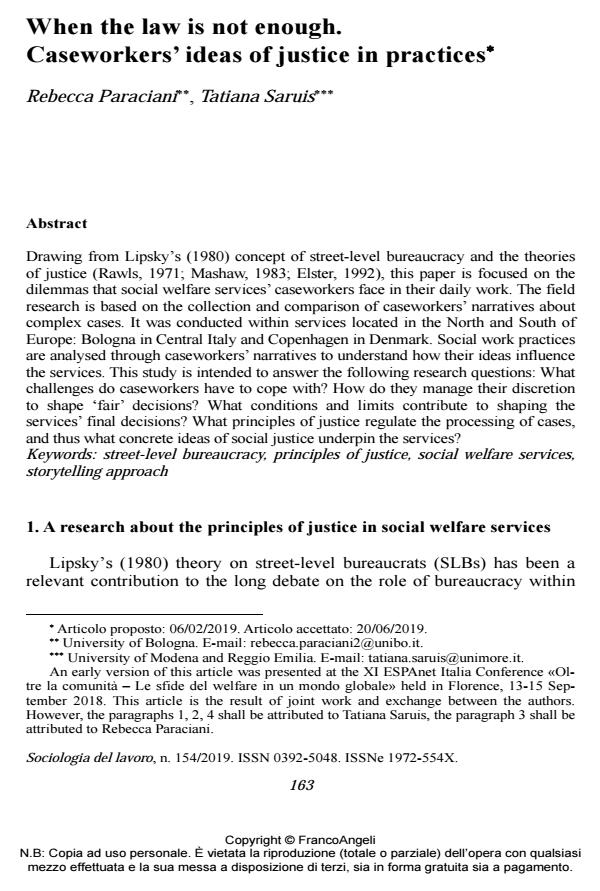When the law is not enough. Caseworkers’ ideas of justice in practices
Titolo Rivista SOCIOLOGIA DEL LAVORO
Autori/Curatori Rebecca Paraciani, Tatiana Saruis
Anno di pubblicazione 2019 Fascicolo 2019/154
Lingua Inglese Numero pagine 20 P. 163-182 Dimensione file 215 KB
DOI 10.3280/SL2019-154009
Il DOI è il codice a barre della proprietà intellettuale: per saperne di più
clicca qui
Qui sotto puoi vedere in anteprima la prima pagina di questo articolo.
Se questo articolo ti interessa, lo puoi acquistare (e scaricare in formato pdf) seguendo le facili indicazioni per acquistare il download credit. Acquista Download Credits per scaricare questo Articolo in formato PDF

FrancoAngeli è membro della Publishers International Linking Association, Inc (PILA)associazione indipendente e non profit per facilitare (attraverso i servizi tecnologici implementati da CrossRef.org) l’accesso degli studiosi ai contenuti digitali nelle pubblicazioni professionali e scientifiche
Drawing from Lipsky’s (1980) concept of street-level bureaucracy and the theories of justice (Rawls, 1971; Mashaw, 1983; Elster, 1992), this paper is focused on the dilemmas that social welfare services’ caseworkers face in their daily work. The field research is based on the collection and comparison of caseworkers’ narratives about complex cases. It was conducted within services located in the North and South of Europe: Bologna in Central Italy and Copenhagen in Denmark. Social work practices are analysed through caseworkers’ narratives to understand how their ideas influence the services. This study is intended to answer the following research questions: What challenges do caseworkers have to cope with? How do they manage their discretion to shape ‘fair’ decisions? What conditions and limits contribute to shaping the services’ final decisions? What principles of justice regulate the processing of cases, and thus what concrete ideas of social justice underpin the services?
A partire dal concetto di street-level bureaucracy (Lipsky, 1980) e dalle teorie della giustizia (Rawls, 1971, Mashaw, 1983, Elster, 1992), questo articolo analizza i dilemmi che gli operatori dei servizi sociali affrontano nella loro quotidianità. La ricerca sul campo è basata sulla comparazione di narrazioni raccolte dagli operatori riguardo ai loro casi. È stata condotta presso due servizi situati nel Nord e nel Sud dell’Europa: Bologna (IT) e Copenaghen (DK). I racconti degli operatori sono stati analizzati al fine di comprendere se e come le loro idee possano influenzare le pratiche dei servizi. Questo studio si propone di rispondere alle seguenti domande di ricerca: quali sono le sfide che affrontano gli operatori sociali nello svolgimento del loro lavoro? In che modo impiegano gli spazi di discrezionalità di cui dispongono per prendere decisioni che ritengono ‘giuste’? Quali condizioni e limiti e quali principi di giustizia influenzano le decisioni sui casi assunte dai servizi?
Parole chiave:Street-level bureaucracy, principi di giustizia, servizi sociali, storytelling
- Labour Inspectors in Italy Rebecca Paraciani, pp.9 (ISBN:978-3-031-37996-3)
- Labour Inspectors in Italy Rebecca Paraciani, pp.43 (ISBN:978-3-031-37996-3)
- Organising Changes: The Institutional Work Behind the Implementation of a Minimum Income Scheme Tommaso Frangioni, Stella Volturo, in Social Policy & Administration spol.70026/2025
DOI: 10.1111/spol.70026 - Who is the (“Ideal”) Victim of Labor Exploitation? Two Qualitative Vignette Studies on Labor Inspectors’ Discretion Kim Loyens, Rebecca Paraciani, in The Sociological Quarterly /2023 pp.27
DOI: 10.1080/00380253.2021.1974321
Rebecca Paraciani, Tatiana Saruis, When the law is not enough. Caseworkers’ ideas of justice in practices in "SOCIOLOGIA DEL LAVORO " 154/2019, pp 163-182, DOI: 10.3280/SL2019-154009